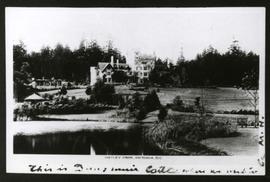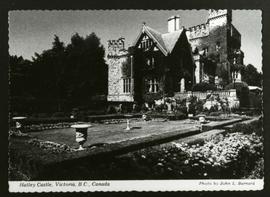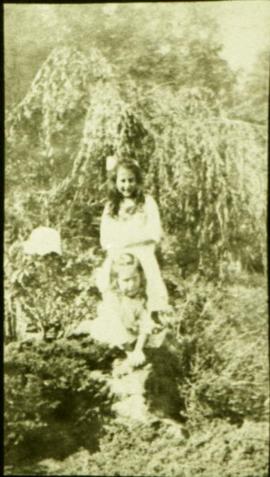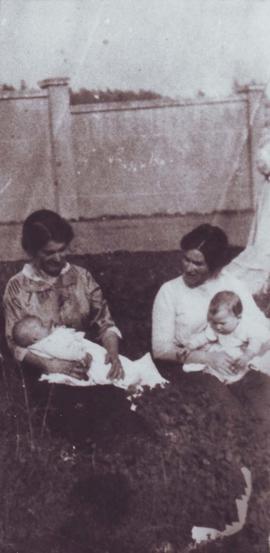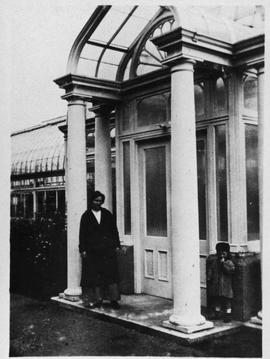This whole page from the photo album shows three images. The centre image, a forest road, is possibly at Hatley Park.
The clipping is part of an advertisement for Lord and Burnham Greenhouses, published in the Florists' Review, October 26, 1916. Note that the headline incorrectly places Hatley Park in Vancouver, B.C., and incorrectly titles James Dunsmuir as a Lord.
The greenhouse and conservatory were constructed and installed by the Lord and Burnham Company and they later used the estate installation in their promotional material. The glass house complex had a full time manager and required 60 tons of coal and 200 cords of wood per year to heat. The ornate conservatory had a central dome of about 30 ft square, with two side galleries, each 60 ft long. Flowers were grown inside that were intended for display in the castle and in later years it was also used for food production. According to a former gardener, interviewed in the 1950s, Laura Dunsmuir said that the conservatory was an extravagance in a private garden and that it should be in a public park.
Postcard may be from a later date than the images in the album. The handwritten caption "This is Dunsmuir Castle where we lived in Ca. MH" was most likely written by Minnie Hayward, wife of Phillip Francis Hayward, the gardener.
Phillip Francis Hayward and his family lived in the gardener’s cottage on the west side of the walled garden. His youngest daughter, Frances, was born there in 1913. In this image, the children can be seen playing in the front yard of the cottage as a truck is passing by on the road outside the walled garden.
Postcard image of the Italian garden at Hatley Park by John L. Barnard. The postcard may be more modern than the period for other images in this album. It may have been collected by Ella Hayward at a later date.
Clipping is from the front page of the Victoria Daily Times, June 7, 1920, the day after James Dunsmuir died.
The image shows the castle newly completed, although the label is signed by Mrs. Humphreys. Kathleen Dunsmuir married Arthur Selden Humphreys in 1915 so the Christmas card cannot predate 1915.
The greenhouse and conservatory were constructed and installed by the Lord and Burnham Company and they later used the estate installation in their promotional material. The glass house complex had a full time manager and required 60 tons of coal and 200 cords of wood per year to heat. The ornate conservatory had a central dome of about 30 ft square, with two side galleries, each 60 ft long. Flowers were grown inside that were intended for display in the castle and in later years it was also used for food production. According to a former gardener, interviewed in the 1950s, Laura Dunsmuir said that the conservatory was an extravagance in a private garden and that it should be in a public park. This image is part of advertisement in the Florists' Review, published October 26, 1916.
This toy car is also visible in the K. McCann fonds, image 1-3-85, where an adult woman is seated in the car in the Italian garden.
Ella Hayward and Harry Mann, the youngest son of the coachman, were friends and often played together around the Hatley Park estate.
The stables and garage building was added as part of the extensive estate development by Brett and Hall, 1912-1914. The building was U-shaped with the stables on the east side and the garages on the west. Homes for the head coachman and the chauffeur were attached at the north end of each wing. The land around the building was cultivated for growing cereal crops.
Harry Mann was the youngest son of the coachman and friends with Ella Hayward. He is sitting on the railings of a rustic fishing bridge at the north end of the pond in the Japanese garden.
The greenhouse and conservatory were constructed and installed by the Lord and Burnham Company and they later used the estate installation in their promotional material. The glass house complex had a full time manager and required 60 tons of coal and 200 cords of wood per year to heat. The ornate conservatory pictured had a central dome of about 30 ft square, with two side galleries, each 60 ft long. Flowers were grown inside that were intended for display in the castle and in later years it was also used for food production. According to a former gardener, interviewed in the 1950s, Laura Dunsmuir said that the conservatory was an extravagance in a private garden and that it should be in a public park.


